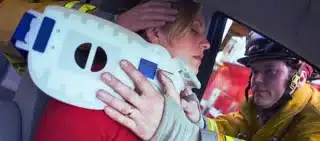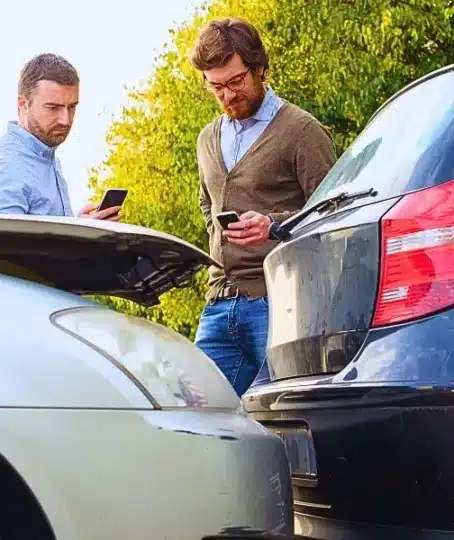
What to Do If You’re Injured in a Car Accident While Working in Illinois Work-related car accidents are common. Between...


Knowing how to prove that you are not at fault in a car accident, can help ensure that you are not held financially liable for injuries or damages suffered by others. In an accident, the at-fault driver is liable for compensating other people who have suffered damages as a result of the crash. Proving that you are not at fault can be accomplished by showing that the other driver failed to exercise reasonable care while on the road, resulting in the collision.
Recent statistics indicate that there were 5.25 million police-reported crashes in 2020, which resulted in the injury of approximately 2.28 million individuals and the death of nearly 39,000 people. Of those incidents, over 3.6 million involved only property damage. All these accidents resulted in an estimated cost of $474 billion. This high number of accidents and related expenses has led to many legal disputes arising between feuding drivers. If you have been involved in a collision, it is important to know how to establish that you were not at fault, so that you can receive compensation for any losses incurred.

In personal injury law, the notion of fault is crucial in enabling the victim to receive compensation for his or her injury. In a Bloomington car crash case, the person who is found to be at fault is held financially responsible for the harm suffered by others, usually through his or her insurance company.
So, how does Illinois determine fault in car accidents? When it comes to car accident claims and personal injury cases, proving fault requires showing that the responsible party was negligent. If you were negligent in a car accident, you are considered at fault. To establish fault in such a case, you must prove four key elements:
The duty of care arises when there is a relationship between the parties that requires the defendant to act in a certain way to prevent harm to the plaintiff. In a car accident, this duty is almost always present because all drivers are legally obligated to act with proper care and caution towards other drivers, passengers, motorcyclists, bicyclists, and pedestrians.
A person is deemed to have breached the duty of care by failing to act with reasonable care under the circumstances. For example, a driver can breach his or her duty of care by speeding, running a stop sign, driving distracted, or driving while intoxicated.
To establish fault, you need to show that the other driver's conduct caused the accident. If the accident happened due to an oil spill on the road, for instance, it would not be the fault of the driver. However, if the accident was caused by the other driver's reckless driving, then he or she would be at fault. The evidence from the accident will be reviewed to determine the car crash's cause.
Finally, you need to prove that you have suffered a legally recognized harm as a result of the accident. This can take the form of injury or damage to property. It is not sufficient to show that the other driver failed to act with reasonable care; you must show that the failure to do so caused you actual damages. If you have not suffered any damages, you have no claim to make. Damages can be economic, such as medical expenses and lost income, or non-economic, including emotional anguish or pain and suffering.
The first steps that you take after an accident can be critical in proving the other driver's fault or disputing your level of fault when seeking a payout or defending against a lawsuit.
Below are the steps to take after a car accident to build a strong case:
If you feel any pain or discomfort after the accident, see a doctor or go to the emergency room immediately. Prompt medical attention is important for your health and can help support your injury claim.
Get the other driver's name, address, driver's license number, car insurance company and policy number, phone number, email address, and license plate number. This information can help you when filing a claim.
If a law enforcement officer comes to the scene of the accident, he or she may write a report that includes his or her opinion on who violated traffic laws and caused the accident. You can request a copy of the report from the law enforcement agency.
Take pictures of your car before getting it repaired. The location of the damage can help prove the other driver's fault.
If there are neutral witnesses to the accident, get their contact information and ask them to write down a description of what happened. Witnesses can provide valuable information when determining fault.
Take pictures of the accident scene from all angles, including close-ups and from a distance. Document all traffic signs, skid marks, the location of any debris, and road conditions. This information can help paint a clear picture of how and why the accident occurred.
When filing an insurance claim or a lawsuit resulting from a car accident, collecting evidence is crucial to determine the cause and its consequences. It is important to provide as much documentation as possible to support your claim for injuries and other damages.
Car damage can aid in determining fault, which may also be assessed by the police and insurer. For instance, if a driver rear-ends another car, it would be simpler to prove that the driver behind is to blame. Therefore, it is essential to take pictures and videos of damaged vehicles following an accident.
Those who are injured in accidents should seek medical treatment as soon as possible. Even if you don’t feel injured, you should see a doctor because many injuries aren't immediately apparent, such as head injuries, or may manifest slowly, such as soft tissue injuries. A doctor can take note of your injuries and the details of how your injuries occurred, which may serve as evidence in the future. Documenting your injuries through your medical records can also justify your damages by proving the costs required for your treatment.
Surveillance cameras are often installed in public places. If an accident occurs in an area monitored by surveillance cameras, it is crucial to check if the event was captured on camera. A video of the accident can be helpful in determining fault.
The evidence at the scene of a complicated accident, such as one involving more than one vehicle, may need to be evaluated by a forensic analyst. A forensic analyst can examine photographic evidence, police reports, eyewitness accounts, and medical records to decipher the likely path and speed of the automobiles, where the impact occurred, and, if possible, who caused the collision.
A copy of the police report, as well as eyewitness testimony, can also serve as crucial evidence.
Following a car accident, the victim has the right to file a lawsuit to recover damages and compensation for his or her injuries. The court will determine who was at fault by considering the level of negligence on the part of the defendant.
In your case, the court will evaluate arguments from the lawyers of both parties and consider various evidence presented by them. This includes testimonies from drivers, witnesses, police officers, doctors, and accident reconstructionists.
The court's decision will be based on the evidence presented to establish whether the other driver was negligent and must pay compensation for any injuries and other losses. Keep in mind that evidence of a traffic violation, like a citation, may persuade the court that the party who committed the violation was acting negligently and is therefore at fault for the accident. This is called negligence per se, and it can be very helpful to your case if you were injured by a driver who violated traffic laws.
Car accidents can be chaotic and leave you confused about what to do next. Seeking legal help from a Bloomington car accident lawyer is crucial in such situations. Your lawyer can investigate the collision and gather evidence to prove your right to damages. They can also identify the applicable insurance policy, file your insurance claim, negotiate a settlement, interview witnesses, request a copy of the police report, calculate your injury-related losses, and take your case to court if necessary. Having an experienced attorney by your side can make the process smoother and increase your chances of receiving fair compensation.

What to Do If You’re Injured in a Car Accident While Working in Illinois Work-related car accidents are common. Between...

Why Pedestrian Accidents in Parking Lots Surge During Summer in Illinois As temperatures rise, more individuals tend to engage in...

Drowsy drivers are a serious and often overlooked danger on Illinois roads. Each year, fatigued drivers contribute to thousands of...